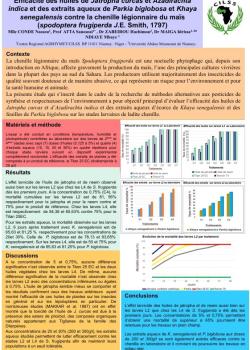Introduction
The fall armyworm (*Spodoptera frugiperda*) is a phytophagous noctuid moth which, since its introduction into Africa, has severely affected maize production, one of the main staple crops in most sub-Saharan countries. Farmers predominantly use insecticides of often questionable quality and in an abusive manner, posing risks to the environment as well as to human and animal health.
Recommendations
Materials and Methods
The trial was conducted under controlled conditions (temperature, humidity, and photoperiod) in the laboratory on 2nd and 4th instar larvae, with seven (7) oil doses (0.125 to 5%) and four (4) aqueous extract doses (10, 15, 20, and 30%), in four replications for each larval stage, following a completely randomized experimental design. The effectiveness of the plant extracts was compared to a reference product, Titan 25 EC (Acetamiprid at 25 g/l).
Results
The larvicidal effect of jatropha and neem oil was observed on both L2 and L4 larvae of *S. frugiperda* from the first days. At a concentration of 0.75% (C4), cumulative mortality on L2 larvae was 81% and 56% for jatropha and neem respectively, compared to 75% for the reference product. For L4 larvae, mortality was 84.38% and 65.63% respectively, compared to 75% for Titan 25 EC. Regarding aqueous extracts, mortality observed on L2 larvae six days after treatment with *K. senegalensis* was 65.63% and 81.25% for concentrations of 20% and 30% respectively. For *P. biglobosa*, it was 78.13% and 93.65% respectively. On L4 larvae, mortality reached 50% and 75% for *K. senegalensis*,


